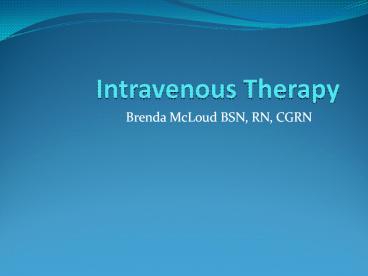Intravenous%20Therapy - PowerPoint PPT Presentation
Title:
Intravenous%20Therapy
Description:
Brenda McLoud BSN, RN, CGRN One way of correcting fluid & electrolyte disturbances is by IV administration of solutions containing necessary electrolytes & nutrients. – PowerPoint PPT presentation
Number of Views:373
Avg rating:3.0/5.0
Title: Intravenous%20Therapy
1
Intravenous Therapy
- Brenda McLoud BSN, RN, CGRN
2
Learning Objectives
- Describe the Nurses role in IV therapy care
- Explain IV supplies, type of vascular access
devices, and administration of IV therapy
3
GI nurses role in IV therapy
- Assessment
- Planning
- Implementation
- Evaluation.
4
Competencies in IV Therapy for the GI Nurse
- Knowledge of Vascular Access Devices (VAD) used
- Skill in performing procedure competently
safely - Skill in inspecting insertion site
- Ability to problem solve
- Knowledge to monitor patients condition report
changes - Proper documentation and record-keeping skills
5
Basic Principles of Fluid Electrolytes
- Water is 60 of the average adults total body
weight - In infants, body water represents about 80 of
total body weight - Solutions liquids (solvents) containing
dissolved substances (solutes) are classified
according to their concentration or tonicity and
include - Isotonic Solutions
- Hypotonic Solutions
- Hypertonic Solutions
- Body fluids are isotonic solutions
6
Basic Principles of Fluid Electrolytes
- Body water is contained in two major body
compartments - Intracellular fluid (ICF)
- Extracellular fluid (ECF)
- Fluid balance is maintained when water intake
equals water output - Solutes are substances dissolved in a solution
7
Basic Principles of Fluid Electrolytes
- Solutes are classified as
- Nonelectrolytes
- Electrolytes
- Cations
- Na, K, Ca, Mg, H
- Anions
- Cl, P, HCO3
- Electrolytes perform four essential functions
- Promote neuromuscular irritability
- Maintain body fluid osmolality
- Regulate acid-base balance
- Regulate distribution of body fluids among body
fluid compartments
8
Fluid Electrolyte imbalances
- Imbalances may result from
- Vomiting, diarrhea, suction, draining wounds,
intestinal obstructions, draining fistulas,
hemorrhage, infections, fever or prolonged use of
enemas - Infants are more vulnerable because of their
higher proportion of body fluid, immature
kidneys, increased heat production rapid growth - Excessive loss of body water can lead to
dehydration
9
Administration of Fluids Electrolytes
- All IV solutions are considered medications
- Requires a Dr.s order
- Types of Solutions
- Isotonic Solutions
- 0.9 NS or LR
- Hypotonic Solutions
- 0.45 NaCl
- Hypertonic Solutions
- 3 NaCl or 10Dextrose
10
Risks for the GI Nurse
- Primary risks due to needlesticks
- Injury
- Disease transmission
- Spills
- Splashes
- Because universal precautions require use of
gloves when dealing with blood and body fluids,
development of latex allergies pose a concern for
health care workers and patients
11
Latex allergies
- Individuals who develop burning or tingling
around mouth after blowing up latex balloons - Known allergy to
- Bananas
- Avocados
- Potatoes
- Tomatoes
- Poinsettias
- History of contact dermatitis
- History of asthma
- History of eczema
12
Vascular Access Devices (VAD)
- Steel winged infusion set (butterfly winged
device) - Peripheral short IV catheters
- Peripheral long or midline catheters
- Peripherally inserted central catheters (PICC)
- Nontunneled central venous catheters (CVCs)
- Tunneled central venous catheters
- Totally implanted devices or ports
13
IV Insertion sites
- Preferred sites
- Dorsum of hand
- Upper arm
- Avoid Extremities with
- Lymphedema, postop swelling, recent trauma,
dialysis shunt, hematoma, axillary lymph node
dissection, local infection or cellulitis,
phlebitis or open wounds - Best to begin with distal veins and proceed
proximally towards the body - Cannulation of lower extremities should be
avoided in adults
14
Complications
- Infiltration/extravasation
- Hematoma
- Phlebitis
- Pyrogenic reactions
- Air embolism
- Catheter embolism
- Pulmonary edema
- Speed shock/overload
- Nerve injury
15
IV Medication Administration
- Techniques routes of administration
- Appropriateness of the prescribed therapy
- Patients age and condition
- Any medication allergies
- Dose, route and rate of the medication ordered
- Medications
- Indications
- Actions
- Side effects
- Appropriate nursing interventions with adverse
reactions
16
Indications for IV meds in GI
- Moderate sedation/analgesia
- Control of variceal hemorrhage
- Treatment of opioid-induced respiratory
depression - Treatment of benzodiazepine-induced respiratory
depression - Treatment of cardiac dysrhythmias
- Reducing peristalsis or intestinal spasms
- Treatment for increased risk of infection
17
Blood Blood Components
- Whole blood
- Packed red blood cells
- Leukocyte-poor blood
- Platelets
- Fresh frozen plasma (FFP)
- Cryoprecipitates
- Factor VIII
- Factor IX
- Human albumin
- Autologous transfusion
18
Adverse Reactions
- Circulatory overload
- Allergic reactions
- Hemolytic reactions
- Hepatitis B, hepatitis C and human immune
deficiency viruses - Other transfusion-related infectious agents
- Citrate toxicity
19
When Adverse Reaction Occurs
- Stop the transfusion
- Keep vein open with normal saline
- Asses vital signs
- Notify Dr.
- Notify blood bank
- Send all transfusion containers administration
sets to blood bank - Treat patient symptomatically supportively
- Patient Education
- Documentation
20
Review
- Salts that dissociate in solution into positive
and negative ions are called - A. Anions
- B. Cations
- C. Electrolytes
- D. Colloids
21
Review
- Drugs should never be added to blood transfusions
because - A. They are incompatible.
- B. It complicates determination of the source of
any adverse reaction. - C. Drugs can cause clotting.
- D. The rate of infusion is too slow.
22
Review
- The following may indicate a higher risk for
latex allergy except, - A. History of asthma.
- B. Use of powder-free gloves.
- C. Allergy to bananas
- D. History of multiple surgical procedures.
23
Review
- Hemolytic reactions to blood transfusions usually
occur - A. Immediately
- B. Within the first 5 to 15 minutes of the
transfusion. - C. Within 24 hours.
- D. As long as 6 months after the transfusion.

